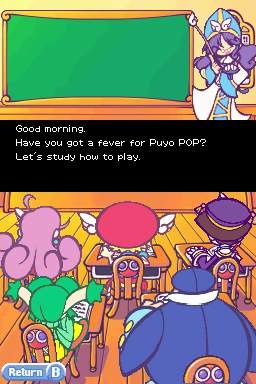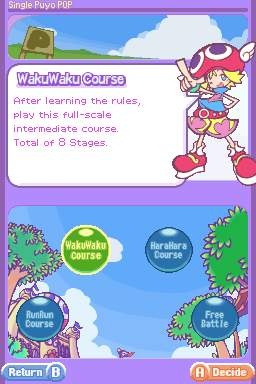Considering that the Soviet blockbuster Tetris served as the springboard for the original Game Boy, it's kind of surprising that we've yet to see a real system-selling puzzle game for the Nintendo DS. Make no mistake: Puyo Pop Fever is not that killer app. It's a port of a fairly modest GameCube game released last year--a game that was itself just a prettier version of a game Sega has released over and over again for the past decade. It doesn't take advantage of the dual-screen format at all, and its touch-screen support is all knees and elbows. But this doesn't stop Puyo Pop Fever from succeeding on the strength of its underlying gameplay, as well as its rather liberal approach to multiplayer.

To win at Puyo Pop Fever, you need to be able to think methodically, as well as act quickly, which makes the game's awkward touch-screen controls basically useless. Most of the time, all the action takes place on the top screen, leaving the lower screen as kind of dead space. You can tap on the lower screen to rotate the pieces that are currently in play, and you can drag the stylus around the screen to move the pieces where you want them. But it's a method that's just not fast or precise enough to serve much good.
Puyo Pop Fever puts a cheery, colorful wrapper around the action with a single-player story--set in a Harry Potter-turned-anime sort of universe--that pits you against a series of bizarrely cute characters. This mode, while not particularly long, does offer a number of genuinely challenging opponents, and it's a decent substitute for playing against live opponents. If you're playing solo, there are also three different "endless" modes, which will keep going as long as you can keep up. These include a traditional Puyo Pop game, a mission mode that presents you with a series of specific tasks you must complete before a timer runs out, and a dedicated fever mode, which has you constantly trying to clear the entire screen in one fell swoop.
The single most impressive aspect of Puyo Pop Fever for the DS is the way the multiplayer game is structured. The game has support for up to eight players. There's nothing too revolutionary about that on its own. However, you can initiate a full-featured, eight-player game with just a single copy of the game. The startup time can be a little brutal with just one cart, since it takes about a minute to transfer all the necessary data wirelessly to one of your opponents, but this option adds an incredible amount of value to the package. There are several different rule sets to choose from, and you can even customize your own rules. If you have a copy of Puyo Pop Fever, anyone you meet with a Nintendo DS is a potential opponent. Frankly, the only thing missing from this package is online multiplayer support.
Sonic Team has maintained a laserlike focus on giving its games an intensely cute, cheery look, and Puyo Pop Fever doesn't break this trend. There's a nice unified look to the game, and everything runs smoothly. There are plenty of big, colored particle effects whenever you clear some pieces, and the background gets downright psychedelic when you enter the fever mode. There are some other nice, smaller touches that help bring everything together, such as the various looks the different-colored gumdrops have, which gives each color a sort of unique bit of personality.

Bright primary colors definitely work to the advantage of a game where the gameplay itself depends on different colors; however, the game's overenthusiastic sound design ends up being screechy and annoying. The music, which could be charitably described as techno for kids, is layered over with the high-pitched voices of the characters, who will chime in whenever anything of importance happens. There's an option to switch to Japanese voices, though it also changes all the menu options over to Japanese as well. In both languages, though, we ran into a terrible sound bug where the character we were playing as would just constantly repeat the same phrase over and over. It didn't happen all the time, but this bug, coupled with the inherently grating sound design, made it easy for us to kill the sound entirely.
For a puzzle game to have real longevity, it needs to be able to marry the two rather disparate concepts of basic, easy-to-learn gameplay and significant strategic depth. Puyo Pop has had this from the beginning, and Puyo Pop Fever maintains this tradition. The new fever gameplay helps pick up the pace, and the single-cart multiplayer options make this an astonishingly great value for multiplayer puzzle fans. If you can tolerate the forcibly cute presentation, you'll find Puyo Pop Fever to be a solid, addictive puzzle game.